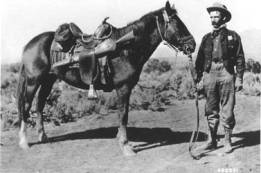A New Profession Takes Seed

OVERVIEW
A New Profession Takes Seed has students examine the birth of American professional forestry and learn what foresters do. Forestry began in the United States during the Progressive Era, when the federal government began applying scientific management principles to environmental issues, college forestry programs were established, and a foresters formed a professional organization to foster the exchange information and ensure a proper code of conduct. Foresters in the first half of the 20th century emphasized timber production over other uses of the forest. Today's foresters engage in a broad range of activities to manage ecosystems with numerous objectives in mind, including the extraction of raw material, outdoor recreation, water quality, conservation, and aesthetics.
Image Caption: Typical early forest ranger in the Southwest, Jim H. Sizer (seen here in 1910), who served as ranger and assistant supervisor from 1909 to 1943 on the Apache and Tonto national forests. Forest History Society photo.
OBJECTIVE
History
- The student will understand how the Progressive Movement addressed the impact of industrial capitalism on trees and forests.
(Standard 1: Era 7, The Emergence of Modern America) - Describe the role of institutions in furthering both continuity and change.
(Standard 5: Individual, Groups, and Institutions) - The student will analyze and explain ideas and governmental mechanisms to meet needs and wants of citizens, regulate territory, manage conflict, and establish order and security.
(Standard 6: Power, Authority, and Governance)

